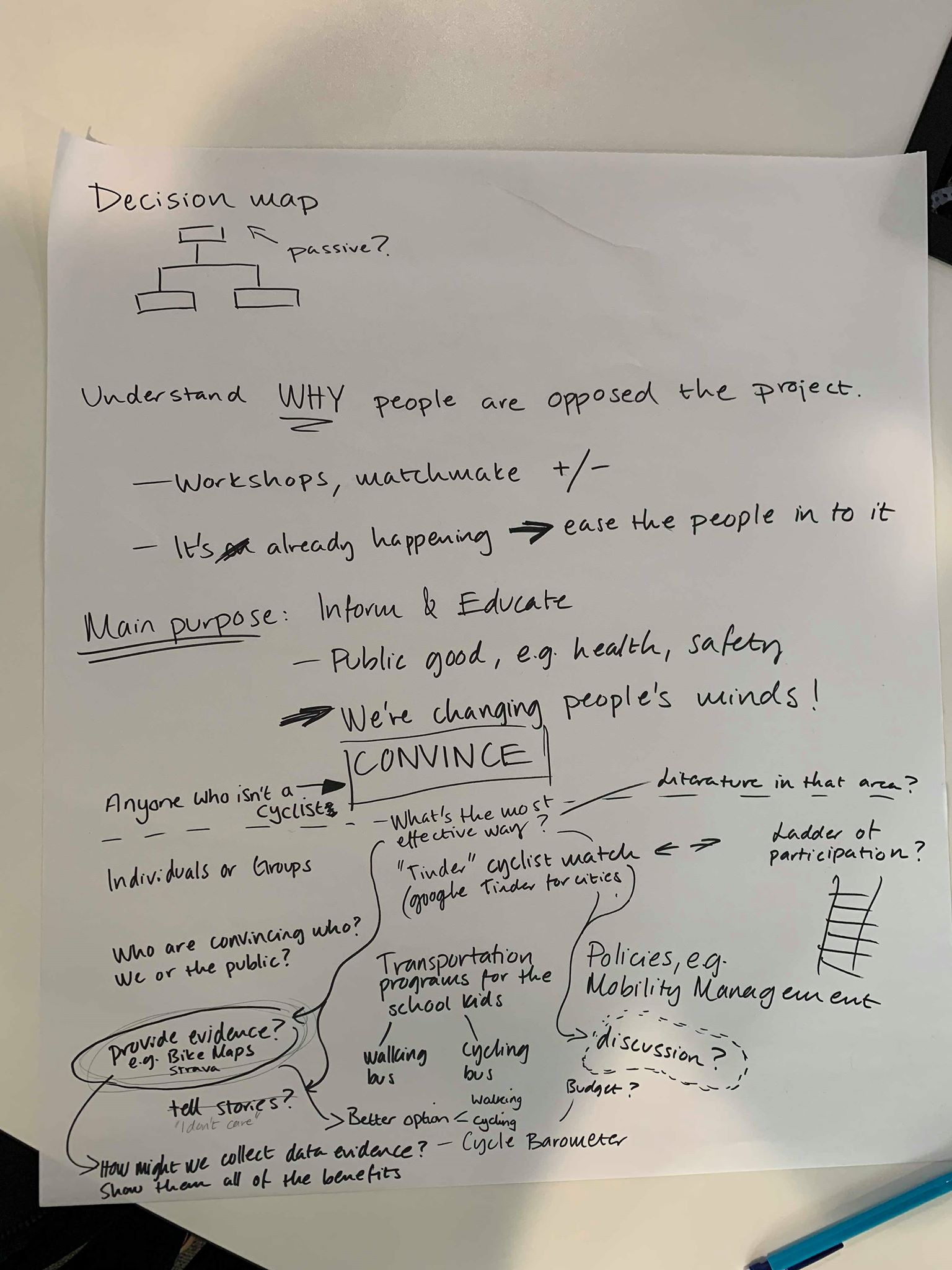LOG WEEK 5
This week we met with one of the academic partners that mentors us, Tom Maskell (PhD student in Open Lab) who happens to have a background in walking and cycling connections for the community. He introduced us to the newcastle walking cycling routes website in which he participated in the creation of. This website was able to show us the main concerns by the general public and where these were located on a map. This is mainly coming from walking and cycling advocates – most comments are green so they believe it is very important, the red and yellow are less important. ( which suggests there are not many drivers as there aren’t many red and yellow.)
https://newcastlewalkingcyclingroutes.commonplace.is/comments/5beefcc45a173b000e05ac22
Our group discussion with our mentor led us to review our project aims as we currently didn’t have a main focus. Tom helped us to understand the best way to use our projects user research and the examples that inspired us to get to the point we are at. He also made us realise that we should do something interactive along Heaton Road that could be seen either by cyclists and pedestrians or drivers.
The Ladder of Participation
Tom reminded us of The Ladder of Participation which we had heard of before but had forgotten about. He explained to us it’s very important to think about our approach to the project and to use this ladder to determine if we wanted more of a manipulative method of making the public more accustomed to the cycle route or if we wanted to be more informing and consult the public more on what they wanted.

Our Best Approach
After an intense group discussion we figured that our best approach should be a more persuasive one, closer to the middle/bottom of the scale, in which we could try to persuade the people sat on the fence or were fully opposed to the cycle route. We came to the conclusion the project is at its final stages of being given the go ahead, with one big final consultation happening in early May and then just the legal processes to be completed, so collecting people’s opinions wouldn’t be as relevant to just trying to change those of the opposed, as the project is shortlisted and one of the councils favourites to happen.

Process
After deciding our main purpose we came up with many different questions of how to actually get across our aim to the public. These questions can be seen in the picture below in which some of our main questions were :
- who’s trying to convince who? Us or the public?
- Will we try to target individuals or groups?
- Would we want to use data/prove, discussions or tell stories to convince people?
In the end we decided our main target would be finding the correct data to answer the question ‘how can people benefit?’ as this would motivate them to change their opinions. We think people would be led by the reduction in costs, health benefits, the advancement in helping the planet (Carbon Footprint reduction), making Heaton a safer environment and if they knew other transport methods were available and easier to use they may be swayed by that.
Conclusion
We have been trying to come up with as many ideas as possible ready for next week in which we are to begin sketching our final project ideas. We still like the idea of a form of an interactive decision map or signs along Heaton Road with phases that show people the benefits of cycling, and we also like the sound of the Cycle Barometers in which Tom introduced us to.
Although the last one may be too much of an expensive method and more focused on the cyclists and not the people who are opposed who’s minds we are trying to change. We are hoping to have made our mind up on this ready for our next lecture.
Hello team, the post is helpful to understand your thought process.. It seems you had a very good discussion with your mentor. The focus on some on-the-street intervention seems great; I also like the idea to bring in evidence into the discussion, perhaps with data from other / comparable transport projects(?). Other than that, perhaps just a couple of things: The ladder of participation is useful in that it gives you a frame of reference. Some might argue that Digital Civics interventions aim at the higher end (delegated power and self-organisation). Not to say not to focus on informing approach, but to continue to reflect on this when you design your final concept.
Hi team, thanks for your post. I am glad to hear that Tom has a been a great help to your team. Your questions are compelling and I look forward to seeing how you will go on to answer them. Your consideration of the Ladder is good – make sure you actually give the paper itself a proper read if you haven’t if you are going to base a lot of your thinking around the ladder. I really have to stress this point though – I have done this in your presentation feedback too – the scheme does NOT already have the go ahead, it is only a shortlisted scheme from Streets for People that is still subject to formal consultation, legal orders and implementation (check the website). If, to you, it appears certain to go ahead or not, I suggest you think about the implications of this for the public’s future involvement in the scheme and their ability to influence it. If it feels like the scheme already has the go ahead, what does this make you think about the upcoming formal consultation on the project? And what is the value of engaging people in this consultation in the project?